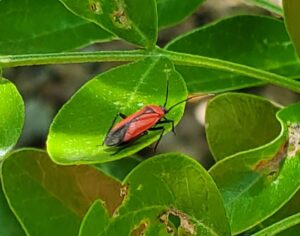The CMG Website is pleased to welcome Wizzie N. Brown to our website. Wizzie is the Integrated Pest Management and Entomology agent for the Travis County AgriLife Extension Service and writes periodic articles on various aspects of entomology. She has agreed to let us post her articles–thank you Wizzie! We think you’ll find them interesting and informative.
Questions? You can contact Wizzie at 512.854.9600 or the website at email@comalmg.com
June 2024–Saltmarsh Caterpillars
 Saltmarsh caterpillars seem to be a common sight in gardens, lawns and traveling across roads and sidewalks. These caterpillars are a particular species, Estigmene acrea, and turn into saltmarsh moths. They are often mistakenly called “woollybears” which are a different species, Pyrrharctia isabella, that turn into Isabella tiger moths. The two species are related and in the same family Erebidae.
Saltmarsh caterpillars seem to be a common sight in gardens, lawns and traveling across roads and sidewalks. These caterpillars are a particular species, Estigmene acrea, and turn into saltmarsh moths. They are often mistakenly called “woollybears” which are a different species, Pyrrharctia isabella, that turn into Isabella tiger moths. The two species are related and in the same family Erebidae.
 Saltmarsh caterpillars are extremely variable in color and have many setae in the late instar which creates a hairy or fuzzy appearance. They have striped or mottled bodies varying from black to brown to yellow and reaching lengths of 2.25 inches. Hairs, or setae, also vary in color and are mostly soft when touched. Hairs are not venomous and do not sting, but some people may be sensitive to the hairs.
Saltmarsh caterpillars are extremely variable in color and have many setae in the late instar which creates a hairy or fuzzy appearance. They have striped or mottled bodies varying from black to brown to yellow and reaching lengths of 2.25 inches. Hairs, or setae, also vary in color and are mostly soft when touched. Hairs are not venomous and do not sting, but some people may be sensitive to the hairs.
Saltmarsh caterpillars actively disperse, and late instar larvae can be seen moving quickly across lawns, landscape beds, sidewalks, roads, and other locations. These caterpillars can move easily into areas and begin to feed on plants. Their chewing mouthparts cause damage to plants by defoliation. They have a wide host range feeding on numerous broadleaf plants including trees, shrubs, crops, and others.
 Adult saltmarsh moths are medium sized and have white forewings with black dots. Hindwings are white in females and peachy yellow in males. The adult’s head and thorax are white, and abdomen is peachy yellow with black oblong spots.
Adult saltmarsh moths are medium sized and have white forewings with black dots. Hindwings are white in females and peachy yellow in males. The adult’s head and thorax are white, and abdomen is peachy yellow with black oblong spots.
Pupae occur in the soil or in leaf litter. Caterpillars spin a cocoon using silk and hairs from the body. There are multiple generations each year in Texas.
Management can be as simple as removing caterpillars by hand; wear gloves while doing so. In backyard gardens, this typically is a feasible method of control. Pesticides such as Bacillus thuringiensis var. kurstaki, spinosad, or botanicals can be used against smaller stages of caterpillars (these are not as hairy as the late instars), but will not kill off late instar larvae.
For more information or help with identification, contact Wizzie Brown, Texas A&M AgriLife Extension Service Program Specialist at ebrown@ag.tamu.edu.
This work is supported in part by the Crop Protection and Pest Management, Extension Implementation Program [award no. 2021- 70006-35347/project accession no. 1027036] from the United States Department of Agriculture (USDA) National Institute of Food and Agriculture.
May 2024–Mountain Laurel Mirid
 Mountain laurel mirids, Lopidea major, are relatively small insects that reach a little over ¼” as adults. Nymphs, or immatures, look like adults, but don’t have fully developed wings and are smaller in size. These mirids are a type of plant bug that is red and black in color. Bodies and front part of the wings are red while the head, antennae, legs, and back part of the wings are black.
Mountain laurel mirids, Lopidea major, are relatively small insects that reach a little over ¼” as adults. Nymphs, or immatures, look like adults, but don’t have fully developed wings and are smaller in size. These mirids are a type of plant bug that is red and black in color. Bodies and front part of the wings are red while the head, antennae, legs, and back part of the wings are black.
They have piercing-sucking mouthparts and use them to puncture foliage of plants. Feeding can lead to deformation of leaves, but doesn’t cause long term damage to the tree, so treatment is optional.
An easy way to decrease populations is to spray the tree with a jet of water. It probably won’t eradicate the population, but it can help to decrease it while conserving the beneficial insect population. If plant size allows, mirids can be hand-picked and either smashed or dropped in a bucket of soapy water or you can tap them into a jar with rubbing alcohol or soapy water. If you want to look at pesticidal options, look at insecticidal soap, horticultural oils, or botanicals. When using any pesticide product, be sure to read and follow all label instructions.
For more information or help with identification, contact Wizzie Brown, Texas A&M AgriLife Extension Service Program Specialist at ebrown@ag.tamu.edu.
This work is supported in part by the Crop Protection and Pest Management, Extension Implementation Program [award no. 2021- 70006-35347/project accession no. 1027036] from the United States Department of Agriculture (USDA) National Institute of Food and Agriculture.
March 2024–Leaf Cutting Ants
 Texas leafcutting ants, Atta texana, are fascinating ants native to Texas, Louisiana, and parts of Mexico. Leafcutting ants create large, extensive colonies, often with multiple mounds clustered in a single area. Mounds are volcano or crater-shaped with a centralized opening and may be mistaken for fire ant mounds, but fire ant mounds do NOT have a centralized opening.
Texas leafcutting ants, Atta texana, are fascinating ants native to Texas, Louisiana, and parts of Mexico. Leafcutting ants create large, extensive colonies, often with multiple mounds clustered in a single area. Mounds are volcano or crater-shaped with a centralized opening and may be mistaken for fire ant mounds, but fire ant mounds do NOT have a centralized opening.
Usually, worker ants of this species, who forage for food, are the most commonly seen leafcutting ants, but in spring it is possible to see reproductive ants, or swarmers. Workers are relatively large ants, reddish-brown in color with three pairs of spines on the thorax and one pair of spines on the back of the head. Workers come in various sizes but can be up to ½ an inch long. Reproductives look similar to worker ants but are much larger in size, with female swarmers being over an inch long.  Mated queens have a special area within their mouth to carry fungal spores used to create a fungus garden in the newly founded nest.
Mated queens have a special area within their mouth to carry fungal spores used to create a fungus garden in the newly founded nest.
Leafcutting ants typically forage when temperatures are cooler, such as at night or in the morning. They can sometimes cause complete defoliation of plants or small trees overnight. These ants remove leaves and buds from plants in the landscape which they chew and get some nutrition from sap, but mainly place chewed leaves in an underground garden within their colony and use it as a base to grow fungus that they eat. Leafcutting ants tend a particular species of fungus and weed out any other fungus from their garden.
Colonies may exist for years and can exceed over two million ants. It is not unusual for a single colony to cover an acre of land. Colonies are usually found in well drained, sandy or loamy soils and are more common in Central to East Texas than other parts of the state.
 Unfortunately, leafcutting ants can be difficult to manage, and almost impossible to eradicate completely. Prized plants can be temporarily protected by using spray adhesives around the base of the plant, but adhesives need to be refreshed often when dirt or debris accumulates. Temporary protection can also be provided to prized plants by utilizing contact insecticidal sprays or dusts labeled for “ants”. These insecticidal products can also be used along foraging trails and openings where the ants go into the ground. If mounds are present, Amdro Ant Block, which is the only product labeled for use against leafcutting ants, can be broadcast with a hand-held spreader in the mound area. You do not want to use ant bait and residual dusts and sprays in the same area as pesticidal dusts and sprays can contaminate bait and cause the ants not to pick it up.
Unfortunately, leafcutting ants can be difficult to manage, and almost impossible to eradicate completely. Prized plants can be temporarily protected by using spray adhesives around the base of the plant, but adhesives need to be refreshed often when dirt or debris accumulates. Temporary protection can also be provided to prized plants by utilizing contact insecticidal sprays or dusts labeled for “ants”. These insecticidal products can also be used along foraging trails and openings where the ants go into the ground. If mounds are present, Amdro Ant Block, which is the only product labeled for use against leafcutting ants, can be broadcast with a hand-held spreader in the mound area. You do not want to use ant bait and residual dusts and sprays in the same area as pesticidal dusts and sprays can contaminate bait and cause the ants not to pick it up.
When managing leafcutting ants, set expectations at managing, not eradicating. Often when you treat, you’ll knock back a portion of the worker population, but the colony will remain.
For more information or help with identification, contact Wizzie Brown, Texas A&M AgriLife Extension Service Program Specialist at ebrown@ag.tamu.edu.
This work is supported in part by the Crop Protection and Pest Management, Extension Implementation Program [award no. 2021- 70006-35347/project accession no. 1027036] from the United States Department of Agriculture (USDA) National Institute of Food and Agriculture.
February 2024–The Exoskeleton…the part of an insect that goes crunch
Insects and other arthropods have an exoskeleton, which means their “bones” are on the outside of their body. The exoskeleton serves as a protective covering, helps prevent desiccation, allows muscles to attach to it from the inside for movement, and provides sensory information.
The exoskeleton is made up of four layers: epicuticle, procuticle, epidermis and basement membrane. The most outer layer, the epicuticle, serves as a barrier to the outside environment and helps the insect avoid desiccation. If you have ever used diatomaceous earth for insect management, you are hoping to abrade the epicuticle of the insect with the diatomaceous earth and cause enough water loss for the insect to die.
 The next layer, the procuticle, is for strength. The procuticle is made of chitin, which is secreted by the underlying third layer, the epidermis. The cuticle is soft when it is first secreted, but undergoes a process called sclerotization, which allows for hardening and darkening of the exoskeleton. The procuticle is divided into two components, the exocuticle and endocuticle. The endocuticle is tough, but flexible while the exocuticle is where thickening occurs to provide a more rigid, armored structure. With soft-bodied insects, such as termites, aphids, or caterpillars, the exocuticle layer is greatly reduced.
The next layer, the procuticle, is for strength. The procuticle is made of chitin, which is secreted by the underlying third layer, the epidermis. The cuticle is soft when it is first secreted, but undergoes a process called sclerotization, which allows for hardening and darkening of the exoskeleton. The procuticle is divided into two components, the exocuticle and endocuticle. The endocuticle is tough, but flexible while the exocuticle is where thickening occurs to provide a more rigid, armored structure. With soft-bodied insects, such as termites, aphids, or caterpillars, the exocuticle layer is greatly reduced.
The epidermis is a layer of living cells that secrete chitin that is used to create the layer above, the procuticle. Any sensory hairs, called setae, that an insect has on its body originate in the epidermis and sensory information travels through the hair on the outside of the insect’s body to nerves found in the epidermis.
The innermost layer is the basement membrane which is a support for the epidermis and a separation from the insect body cavity.
All these layers together make up the insect exoskeleton. The exoskeleton is comprised of hardened plates called sclerites. The composition of plate structure allows the insect to have segmented joints and bodies which allows for movement. Each segment has various thickness of sclerites related to the movement and/ or protection required in that given area of the body. Furthermore, the exoskeleton has various areas that are folded inward, called apodemes, allowing for more surface area of the exoskeleton in that particular region and creating a strengthened area where muscles can attach on the inside of the body.
For more information or help with identification, contact Wizzie Brown, Texas A&M AgriLife Extension Service Program Specialist at 512.854.9600.
This work is supported in part by the Crop Protection and Pest Management, Extension Implementation Program [award no. 2021- 70006-35347/project accession no. 1027036] from the United States Department of Agriculture (USDA) National Institute of Food and Agriculture.